Egypt’s development throughout the years has been visually documented by its flags as it transitioned from monarchy to modernism. The Egypt flag is an obvious symbol of a country’s sociopolitical and cultural tendencies. After numerous phases of development, today it reflects the country’s current ideology. Every morning, Egyptian students all around the country stand up, face the flag of Egypt, and sing the national hymn.
If you want to learn more about the Egypt flag, its origin, history, and development, this article will be a great help.
Briefly About Egypt
To understand the history and development of the Egypt flag up close, it is important to first explore its Geographical characteristics. Well-known Egypt, with its pyramids and extensive history, has been around for 7,000 years. Egypt is home to the Pyramid of Cheops, one of the Seven Wonders of the World. The largest city in both Africa and the Arab world is Cairo, the capital. In terms of art, tourism, and culture, it is the nation’s center. Arabic is the official language in Egypt.
The weather is dry and warm. There are two seasons. The winter season is gentle rather than harsh. Wintertime lows in the south bring the normal 43-degree temperature down to 15 degrees. The difference in temperature between day and night is also extremely significant in the country.
The country observes Eastern European Time all year. There are no time modifications during daylight saving time in Egypt.
Egypt would be entirely deserted if the Nile River did not exist. Every year, just around an inch (2.5 cm) of rain falls in Egypt. However, the river increases every summer as a result of rainfall at its far-off source in Ethiopia. Floods fill the valleys of the river, leaving the sediments required for the growth of trees, plants, and crops.
While Lower Egypt is found in the north, Upper Egypt is found in the south. The Nile runs from south to north, thus the names of the parts.
Southern Egypt contains low mountains and deserts. In northern Egypt, there are broad valleys near the Nile and a desert to the east and west. Cairo, the nation’s capital, is located to the north of the vast, triangular Nile River Delta. There are farms all throughout this productive terrain.
History of Egypt
Mohamed Ali unveiled the first Egypt flag. The Egyptian flag was altered over time; nevertheless, the governments and rulers changed. Over 8,000 years ago, hunters and fishermen became the first humans to dwell along the Nile’s banks. They started to establish towns and villages after learning how to cultivate crops and keep livestock. They learned to sail and engaged in commerce with their neighbors. A civilization had emerged by 3000 B.C.
A strong monarch, later known as a pharaoh, united the kingdoms of Upper and Lower Egypt in 3100 B.C. Huge pyramids, temples, and other structures were constructed by these monarchs. They also took over other nations.
Starting in the late 18th century, Egyptian politics were increasingly influenced by European powers. The British invaded and took control of Egypt in 1882. The Suez Canal, which connected the Mediterranean Sea with the Red Sea and significantly reduced the sailing journey from Asia to Europe, was something the British sought to dominate.
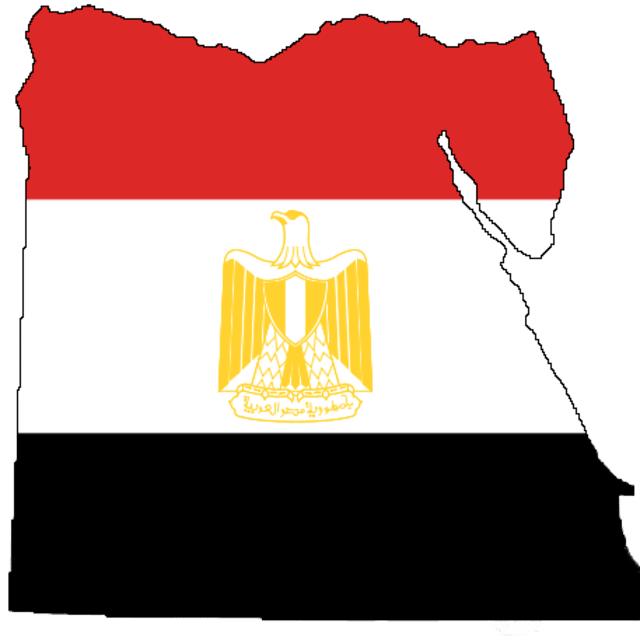
History Of Egypt Flag
First Egypt Flag
When Mohamed Ali took over as ruler of Egypt in 1805, the first Egypt flag was unfurled. It features a crimson flag with three stars and three white crescents on it. The three stars and crescents represented Mohamed Ali’s victory on all three continents: Africa, Asia, and Europe, as well as his rule over Egypt, Sudan, and Hejaz.
The original national anthem was “Al Salam Al Malaky,” written by Italian opera composer Giuseppe Verdi in 1869, under the reign of Khedive Ismail.

Independent Egypt Flag
When the British acknowledged Egyptian independence in 1922, King Fuad I changed his title from the sultan to king. Fuad simultaneously announced the adoption of a new national flag for Egypt, which had three white stars inside a huge white crescent on a green backdrop.
The green backdrop signified Egyptian agriculture, while the three stars stood for Egypt, Nubia, and Sudan. According to some theories, the three stars represented the Muslims, Christians, and Jews who resided in Egypt.
The national anthem from 1923 until 1936 was “Eslamy Ya Misr,” which was penned by Safar Ali and Mustafa Sadeq al Rafale. At the Academy of the Egyptian Police, it is still in use.
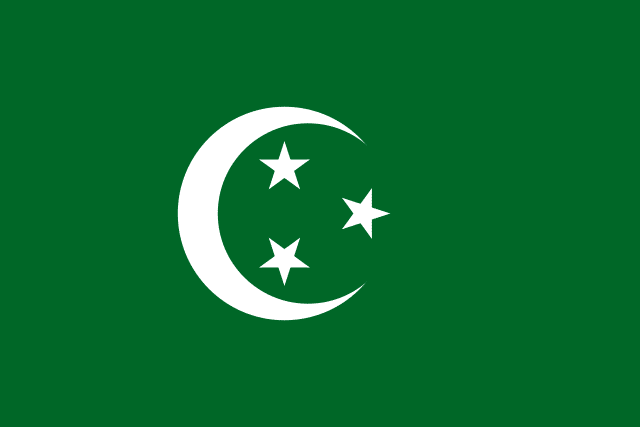
Revolution Flag
The 1952 revolution’s flag, which had red, white, and black stripes, became Egypt’s national flag after the kingdom was legally dissolved on July 18, 1953. Black denoted the end of the tyranny endured at the hands of the monarchy and British colonists. White symbolized the end of the monarchy without violence, and red represented the battle against British rule.
In 1952, Egypt designated “Nashid Al Huriyya,” performed by Egyptian singer Mohamed Abdel Wahab and composed by Egyptian poet and writer Kamel el Shennawy, as its national anthem.
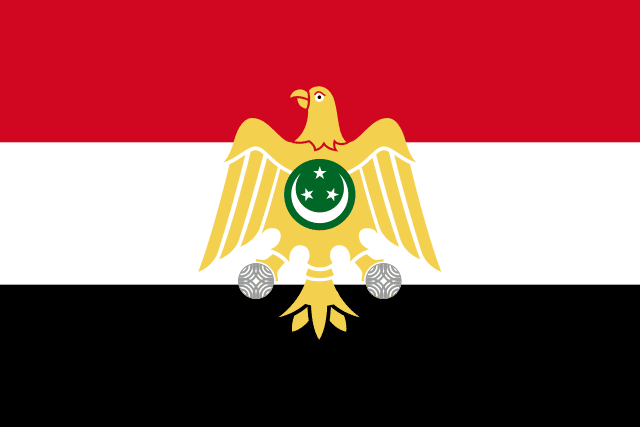
United Arab Republic Flag
The United Arab Republic (UAR), a brief political union founded by Egypt and Syria between 1958 and 1961, chose a national flag that was somewhat reminiscent of the Egypt flag of 1953. The Saladin eagle was replaced with two green stars, which stood in for Egypt and Syria.
Syria formally proclaimed its independence from Egypt on September 28, 1961. Even after the union was broken, Egypt retained the name the United Arab Republic until 1971.
The national song of the United Arab Republic, “Walla Zaman Ya Selahy,” was kept as Egypt’s official anthem until 1979, despite the UAE’s dissolution. Kamal al Tawil composed the hymn, which was performed by renowned Egyptian vocalist Om Kulthum. It was penned by poet Salah Jahine.

Federation of the Arab Republics Flag
Egypt, Syria, and Libya joined together to create the Federation of the Arab Republics on January 1, 1972. The federation’s flag resembled that of the United Arab Republic, but instead of the two stars, it featured the Quraish golden falcon, a symbol of Arab nationalism.
Although this alliance only lasted from 1972 to 1977, a mere five years, Egypt kept the name and flag of the Federation of the Arab Republics until 1984.
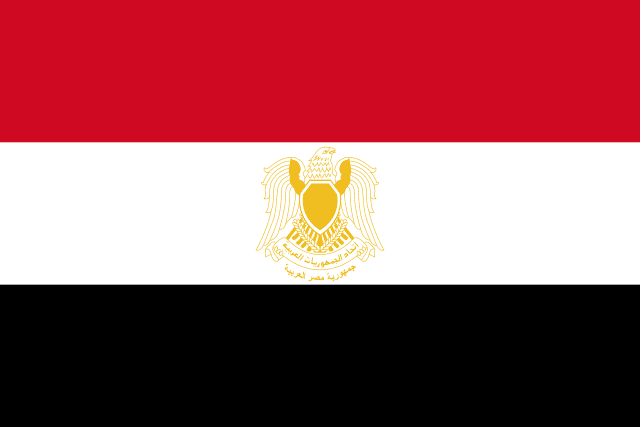
Current Egypt Flag
The current Egypt flag was approved on October 4, 1984. The Arab Republic of Egypt now flies a flag with horizontal red, white, and black stripes.
The current national anthem of Egypt is “Bilady,” which was written by Sayed Darwish and Mohamed Younis al Qaday. The anthem’s lyrics were adapted from a 1907 lecture by Egyptian attorney Mustafa Kamel.
In 1979, Egypt’s third president, Mohamed Anwar Sadat, tasked Mohamed Abdel Al Wahab with recomposing this song.
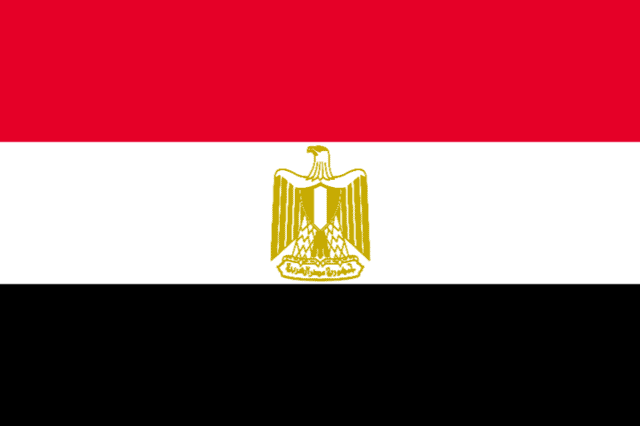
Symbolism Of Egypt Flag
The Eagle of Saladin is displayed in the middle of a horizontal tricolor of red, white, and black that represents Egypt. The red symbolizes the blood Egyptians shed while battling the British. Egyptians first used nonviolent protests as a tactic in their struggle for freedom. They began their campaign for liberation by sending campaigners to the British high commissioner, Reginald Wingate, with a demand that they abandon their protectorate over Egypt and Sudan.
The white stripe on the Egypt flag stands for both the peaceful dissolution of the Egyptian monarchy and peace in Egypt. When Egypt staged a revolution to become a republic, the monarchy came to an end. White is a symbol of the Egyptian people’s innocence during the bloodless revolution. It also connotes optimism for a promising future.
The Egyptians are reminded of the injustice and persecution they experienced during British rule by the color black. It also serves as a reminder to value their freedom of self-rule and a symbol of the end of colonial tyranny when they won their independence from British authority.
One of the strongest and most hardy birds is the eagle, according to legend. Egypt’s national bird, the steppe eagle, is a symbol of the strength and might of the Egyptian people. It also symbolizes Arab nationalism.
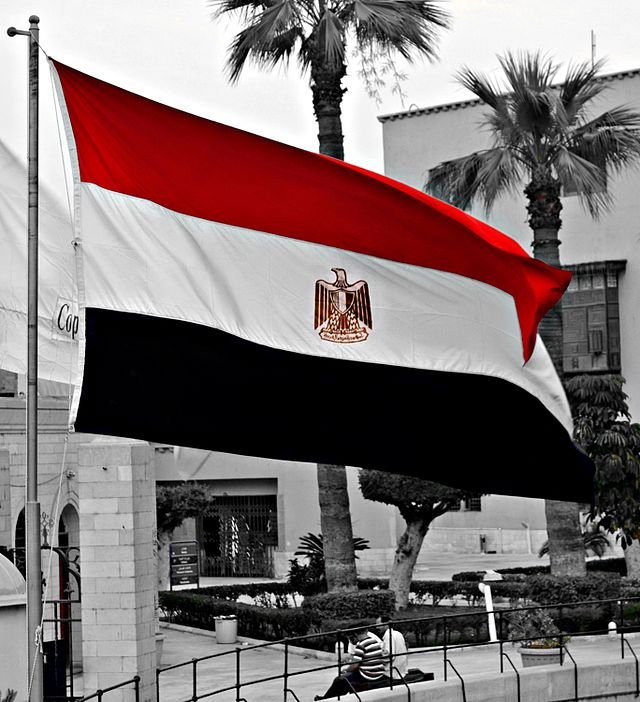
Egypt Flag Protocol
Every Friday, on national holidays, during the House of Representatives opening session, and on any other occasions specified by the Interior Minister, the flag is flown above all Egyptian government facilities. On Revolution Day (July 23), other national holidays, and when the Egyptian President travels to the nation that is hosting the diplomatic mission, the flag is flown above border checkpoints, customs buildings, Egyptian consulates, and embassies abroad.
Any form of flag abuse is illegal and punishable by law since it shows disrespect for the state’s authority. Abuse of foreign flags or national crests of other nations is also subject to criminal penalties.
Bottom Line
Like many other Middle Eastern countries, Egypt employs a design for its flag that combines a national emblem with the banner of the Arab Liberation Movement. Since the founding of the Republic of Egypt, the national emblem on the flag has undergone a few changes, although the basic layout has remained constant.